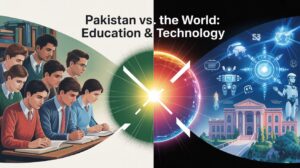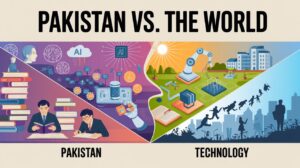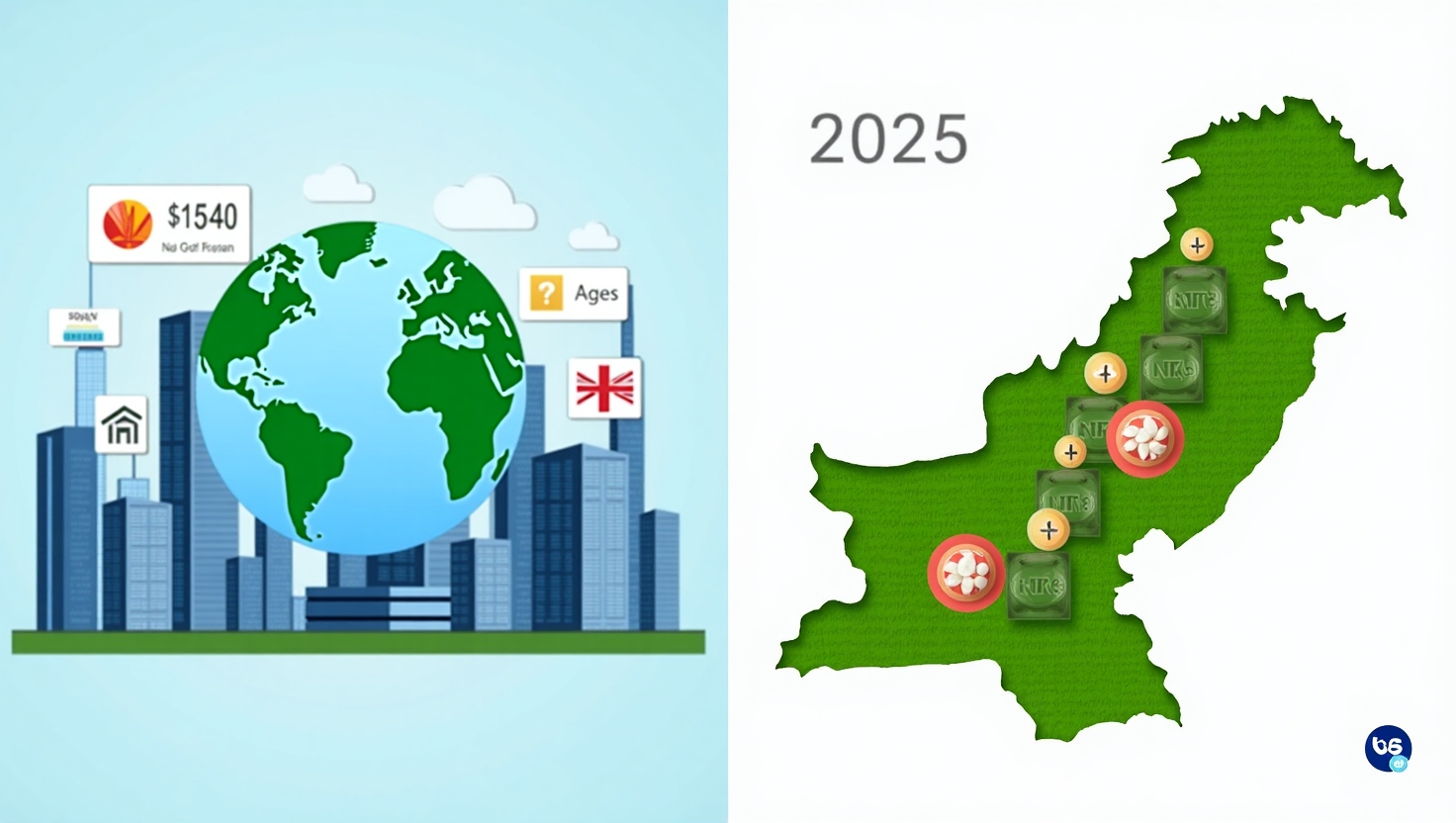The global economy in 2025 presents a mixed picture—while some countries are recovering rapidly from the impacts of COVID and geopolitical shocks, other countries are still mired in persistent economic turbulence. In this markedly complex world, Pakistan is grappling with some of the worst economic challenges including inflation, currency devaluation, debt, and many more structural problems. This article seeks to formulate a comparative analysis of world economy and Pakistan’s economy in 2025 by looking at their relevant economic indicators, trends and forecasts.
1. Global Economic Overview in 2025
According to the International Monetary Fund(IMF), the world economy will experience an increase in growth output of 3.1% for the year 2025. Advanced economies such as United States, Germany and Japan are experiencing steady growth while developing countries such as India and Vietnam are witnessing faster growth owing to technology and manufacturing.
Key Global Trends:
The world is putting more focus on green energy and sustainability
Automation and digitalization are increasing
Stagnating global inflation
Geo political tensions are rising: U.S.-China trade war, Russia-Ukraine war Russia-Ukraine conflict)

Alright, let’s break this down in a more conversational way. So, when it comes to global trade, Asia is still the main player in manufacturing. The EU and the US are trying to bring some of that production closer to home to cut back on their reliance on China. And it looks like foreign investments are bouncing back, especially in tech, green energy, and fintech.
Now, looking at Pakistan’s trade situation, it’s a bit tough. Most of their exports are textiles, which make up about 60%. They’re also dealing with high bills for imports, especially fuel and machinery. This leads to a trade deficit that’s putting a strain on their foreign reserves. Plus, foreign investment isn’t really flowing in because of ongoing political issues and uncertainty.

Pakistan’s not really plugged into the global value chains, which means it’s missing out on benefits from changes in trade patterns.
Switching gears to currencies, in 2025, global currencies like the US dollar, Euro, and Yuan are pretty stable, with some ups and downs based on central bank strategies and what’s happening worldwide. But the Pakistani Rupee has taken a hit, dropping into the PKR 320 to 350 range against the dollar. That’s not great for investor confidence and definitely makes imports more expensive.
Then there’s the issue of debt. After COVID, global debt spiked, but many developed countries are keeping it manageable thanks to strong tax systems. Pakistan, on the other hand, is in a tighter spot:
Their public debt is over 70% of GDP.
More than half of their budget is going to interest payments.
They’re relying on IMF help and loans from countries like China and Saudi Arabia.
GDP Growth Comparison
| Indicator | World Economy (2025) | Pakistan Economy (2025) |
|---|---|---|
| GDP Growth Rate | 3.1% | 2.8% |
| GDP (Nominal, Trillion USD) | ~105 | ~0.37 |
| Per Capita Income (USD) | ~$13,000 | ~$1,500 |
The government’s really struggling to get more people to pay taxes, with only about 2% of folks filing their income taxes.When we talk about technology and human resources, other countries are diving into areas like AI, robotics, digital infrastructure, climate-smart agriculture, and R&D. Pakistan’s falling behind because:
They’re spending less than 2% of their GDP on education.
Their skill development programs aren’t cutting it.
There’s a brain drain, with talented young people leaving.
This lack of skilled workers makes it harder for Pakistan to compete in today’s digital world.
On the social side, while extreme poverty has dropped in many parts of the globe because of economic growth and social programs, Pakistan still has over 40% of its people below the poverty line in some regions. Food scarcity and joblessness are also rising, and while initiatives like Ehsaas and BISP are helpful, they’re facing budget issues.
Looking ahead, there are some lessons and things Pakistan could do to improve. They should invest more in education, tech, and export opportunities. Promoting stable economies and consistent political environments would help, too, along with strengthening governance and improving tax collection.
In short, when we compare the world economy and Pakistan’s situation in 2025, the differences are pretty stark. The global economy is moving forward with tech and green investments, while Pakistan is still wrestling with serious economic hurdles. But with the right reforms, better governance, and smart investments in people and technology, there’s a chance for Pakistan to catch up and benefit from changes in the global economy.
What Pakistan Can Learn from the World Economy:
So, here’s what Pakistan could take from the global economy: first off, putting money into education, tech, and exports could really pay off. It’s also super important to have steady politics and a solid economic plan. Strengthening how institutions work is key, too. And they should definitely work on collecting taxes better and bringing more people into the tax system. Plus, focusing on a greener economy and climate resilience is a must. Looking ahead to 2025, there’s a pretty big gap between how the world economy is doing compared to Pakistan’s economy. While the global scene keeps pushing forward with digital stuff and green investments, Pakistan’s got some major bumps in the road that are holding it back. But hey, with the right reforms, better institutions, and smart investments in people and technology, Pakistan could totally get in on the global economic shifts.
FAQs
1. How does Pakistan’s economy compare to the global economy in 2025?
The global economy is predicted to grow by about 3.1% in 2025, while Pakistan’s economy is predicted to grow by 2.5% to 3% because of structural problems, debt, and inflation.
2. In 2025, will Pakistan’s GDP growth rate surpass or fall short of the global average?
The GDP growth rate of Pakistan is below the global average. Due to internal economic issues, Pakistan is experiencing slower growth, at about 2.8%, while the global growth rate is 3.1%.
3. What are the main economic obstacles Pakistan will face in 2025?
High inflation, currency devaluation, external debt, low exports, energy shortages, and political instability are some of the main obstacles.
4. In 2025, why is Pakistan’s currency losing value in relation to the US dollar?
Trade deficits, negligible foreign reserves, and rising debt servicing are all contributing factors to the devaluation of the Pakistani currency.
5. In 2025, will Pakistan continue to draw in foreign investment?
While other emerging economies are receiving more capital, Pakistan continues to receive relatively little foreign direct investment (FDI) due to political, energy, and policy instability.
6. What distinguishes Pakistan’s export profile from that of other economies around the world?
While global economies have more diverse and value-added industries like technology, machinery, and services, Pakistan’s export profile is dominated by textiles.
7. What can the global economy teach Pakistan?
Pakistan can give priority to political stability, tax reform, human capital development, innovation, and climate-resilient agriculture in order to

